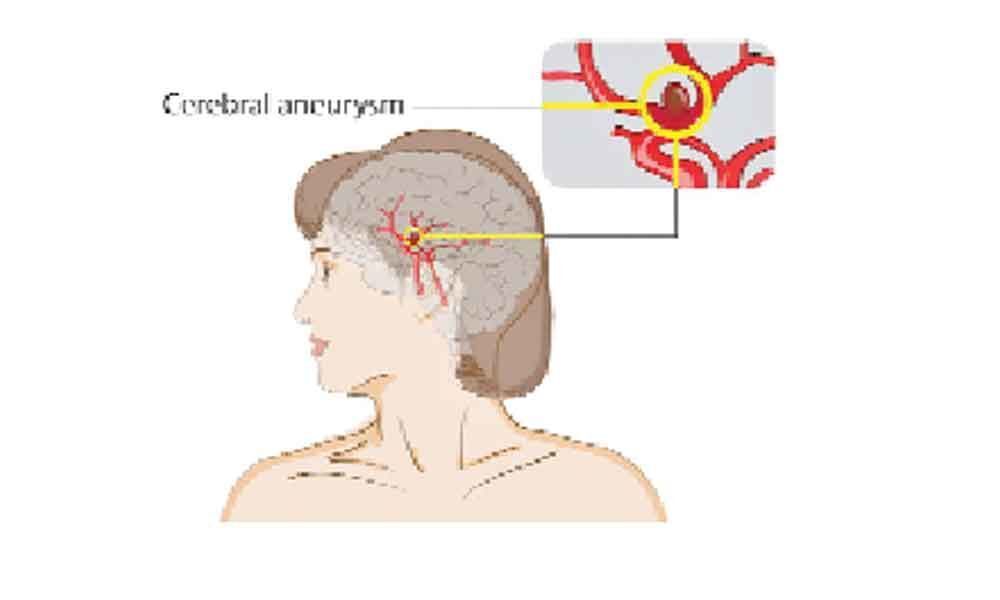Latest tech useful to treat aneurysm

Aneurysm is a swelling that occurs in the blood vessels due to the weakening of its walls that causes a bulgy appearance. Aneurysm can form in blood vessels in any part of the body including arteries and veins and can have serious consequences.
Aneurysm is a swelling that occurs in the blood vessels due to the weakening of its walls that causes a bulgy appearance. Aneurysm can form in blood vessels in any part of the body including arteries and veins and can have serious consequences.
Usually, the most common occurrence of aneurysm has been seen in the aorta, back of the knees, brain or intestines. If the aneurysm gets ruptured, it can even cause internal bleeding and stroke leading to casualty. It is caused by combination of potential risk factors like smoking, advanced age, high cholesterol, hypertension or tissue disorders. The symptoms are only prevalent when it ruptures and intervention is possible depending upon the location size and the condition of aneurysm.
Who is at risk of Aneurysm?
Males are more likely to develop aneurysms than females. Age group of more than 60 years is at higher risk. Other factors may include: Fat and Cholesterol diet; A family history of heart disease and heart attack; Obesity; Smoking; and, Pregnancy can also increase risk of aneurysm of the spleen
Types of Aneurysm
Classification of aneurysm is basically done depending on its location in the body. Blood vessels of the brain and the heart are the most common locations to get seriously affected. The swelling can be of two types- either the complete blood vessel is swollen or a specific side of the blood vessel can bulge out from sides. The following are the most common types of aneurysm
- Aortic Aneurysm: When the swelling is seen in the aorta that is the largest artery starting from the left ventricle to the chest and abdominal cavity. Aortic aneurysm can cause the aorta to swell from its normal diameter of 2.5 cm upto or even beyond 5 cm.
- Abdominal Aortic Aneurysm (AAA) - is the most common aneurysm that occurs in aorta. This aneurysm bulges in the part of the aorta that runs through the abdomen. Timely intervention can not only prevent casualties but also treat the condition.
- Thoracic Aortic Aneurysm (TAA) - is a less known aneurysm that can affect aorta running through chest. The percentage of occurrence is only 25 percent in the chest.
- Cerebral Aneurysm: Intracranial Aneurysms occurs in the arteries that supply blood to the brain. They are also called Berry Aneurysms due to their appearance and also can frequently rupture and bleed. The ruptured aneurysm can be fatal within 24 hours.
- Peripheral Aneurysm: Peripheral Aneurysms develops in arteries other than aorta. It develops in the popliteal artery which runs in the lower part of thigh and knee. It can also develop in the artery located in groin, neck, arms and arteries supplying blood to the kidneys or bowel.
How is it diagnosed?
Usually, aneurysm remains undetected and screening may be required for the patients needing monitoring or treatment. Women being at lower risk of developing aneurysm, men must undergo ultrasound screening for sure around the age of 55 years and above or a regular smoker.
MRI scan is useful for identifying aneurysms that do not rupture but the symptoms are prevalent. Incase the aneurysm gets ruptured and leads to the risk of bleeding in the brain, CT scans are preferred. An Angiogram may be performed in extreme cases with severe rupture and bleeding in the brain to identify the exact area for treatment.
Surgical intervention by Flow Diversion Stent
This device is the new innovative intervention for treatment of aneurysm for the initial stages when it has not ruptured. Flow diverter stent is a pipeline method technique that includes placing a device inside the sac of the parent blood vessel to divert the blood flow from aneurysm. This intervention is an endovascular technique in which a cylindrical, metallic mesh stent is placed inside the blood vessel containing aneurysm. These stents prevents the coils from exiting the aneurysm and maintain the pressure on the coil to keep aneurysm under control. Over a period of time, blood clots on the coil are naturally healed and the blood is diverted away from the vessels that are already weakened to prevent any rupture.
Flow Diversion can be used to treat large or giant wide necked brain aneurysms and is the most effective and the newest technology available for the treatment.
Can it be prevented?
Most of the cases being congenital, it is not always possible to prevent aneurysm. Though certain changes in lifestyle can help prevent the risk –
l Smoking cessation: Smoking is one of the major risk factors for development of aneurysm and its rupture. Immediately stopping smoking can reduce the chances by 80%.
l Maintaining blood pressure – high blood pressure tends to weaken the walls of the blood vessels due to its pressure. Hence maintaining healthy blood pressure reduces the risk of aneurysm. Following a balanced diet intake, regular exercise and medication can maintain a healthy blood pressure.
l Maintain normal BMI – Increased weight puts extra pressure on the heart, hence reducing and maintaining healthy body weight helps in reducing the stress on the walls of the blood vessels.
l Prevent high cholesterol diet – High cholesterol intake leads to plaque buildup inside the blood vessels that causes reduced space for the blood flow. This puts excess pressure and stress on the walls of the blood vessels leading to weakened vessels. This condition is known as atherosclerosis which has a very high linkage to form aneurysm.
(Writer is Director, Neurointervention, Agrim Institute for Neuro Sciences, Artemis Hospital, Delhi)














